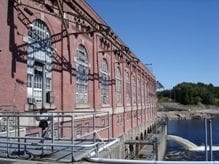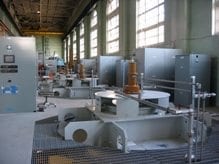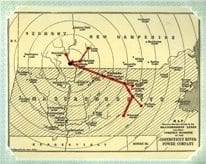Vernon Station: Honoring the Past, Powering the Future

John Ragonese accepts the OSAW award on behalf of TransCanada at NHA’s Capital Hill rally on May 11, 2009.
Summary
Vernon Station, one of New England’s most historically significant hydropower developments, will mark its first centennial of operation in 2009. TransCanada recently completed a major re-powering project to ensure that the Station will continue its role as a significant source of clean, renewable energy to the New England power market in the 21st century.
As the steward of this important Connecticut River landmark, TransCanada has produced a high-definition video for regional distribution to schools, libraries, and museums for the purposes of interpreting the historical value of Vernon Station and documenting the challenging re-powering project with a unique, up close view of the transition between old and new technology.

Vernon Station was the site of a repowering project that TransCanada documented through an educational DVD that captures and celebrates the transition of this remarkable facility into its second century of operation.
Background
Vernon Station was in many ways the cornerstone of New England’s modern-day integrated power system as it was the first hydro station east of Niagara Falls to transmit power over a long distance. The innovative construction techniques and the technology employed represented significant engineering achievements in 1909.
As hydropower technology advanced during the 20 th century, Vernon was periodically upgraded and modernized. With the recent completion of its most significant upgrade, Vernon has again advanced the application of hydropower technology, by replacing the four remaining original three-wheel turbines with advanced axial flow Kaplan runners. These new units provide significant advances in operational range and efficiency and substantially increase Vernon Station’s output.
As part of its plan to address historic resource impacts associated with the upgrade, TransCanada chose to supplement existing Vernon photographic documentation with a video portraying the powerhouse’s historic features; the existing units in operation; the removal of the old equipment; the powerhouse preparations for new units; and the installation of the new units. Completed with preservation of the historic character of the Station at the forefront, the re-powering project offered an opportunity to capture on video Vernon Station’s past and its transition into its second century.

TransCanada’s repowering projects centered on replacing the existing three-wheel turbines with advanced axial flow runners. Under ideal conditions, the new turbines can double the output of their predecessors.
Challenge
From a creative perspective, an overarching challenge was to avoid creating a simple step-by-step documentary and to bring the film to life by making it visually interesting as well as informative. This challenge was met in two ways: by placing the re-powering project into Vernon’s historical context with still photos and historical narration and by capturing the necessary hands-on nature of the work in progress to provide a greater appreciation of the skills needed to complete a project of this scale.
In addition, TransCanada’s collaborative work with both the Vermont and New Hampshire State Historic Preservation Offices (SHPOs) and the Federal Energy Regulatory Commission (FERC) resulted in a Memorandum of Agreement between the parties that formed the framework for the evaluation of construction alternatives and the preservation of significant historic resources.
Fulfilling the Memorandum of Agreement while orchestrating a major renovation project and recording that project in real time required TransCanada to meet multiple challenges. TransCanada officials had to identify key activities and stages in the repowering project to capture in the film; mobilize the independent film crew onsite at the exact times needed to safely document the once-in-a-lifetime changes as they occurred; and maintain coordination and clear communication among multiple stakeholders throughout the two year project.

Vernon Station was the first northeastern hydro plant designed to transmit power at high voltages over long distances. The map above displays the early service area of Vernon Station with electricity provided to communities in Central Massachusetts.
Innovation
The documentary filming required an innovative approach. An independent film production company was chosen because of its expertise and proximity to Vernon. Crew members essentially remained on-call in order to be available to run down to the project site and film important project milestones. Good communication, prior identification of key sequences, and ongoing coordination between the project team, contractors and the film crew were necessary to ensure the safety of both the workers and film crew while videotaping on the construction site.
In addition to the film documentary, the re-powering project itself was innovative. It took extremely creative engineering to structurally modify Vernon Station to accept these drastically different turbine generators from the inside of the powerhouse, without compromising structural integrity or architectural features. Finally, the specification and installation of the four new Litostroj Saxo axial-flow Kaplan turbines was itself, new and innovative. The Vernon Station installation represents the first such installation of these units in the United States, ironically, at one of the country’s oldest hydro facilities.
Results
At the conclusion of the re-powering project in September 2008, TransCanada held Vernon Station’s Centennial Celebration and Open House that featured plant tours, a dedication of a memorial plaque, and a preview of the documentary film Vernon Station – Honoring the Past, Powering the Future. The documentary received high praise at the Centennial Celebration, which attracted over 400 community members, municipal officials, and present and past employees, including a 95-year old retiree who worked at Vernon Station in the 1930’s.
The film captures in striking detail, the unique historical character of Vernon Station, along with archival images of the initial construction and the technological advancements it encompassed. The film also captures the labor intensive processes required to carefully remove early 20 th century equipment and install 21 st century technology. Through the images of the workers, one gets a sense of the pride that went into the initial construction, the sadness that goes with the removal of aged but honored machines, and the excitement of building new hydro capacity.
Stakeholder Quotes
The Hinsdale Historical Society appreciated the opportunity to see Vernon Station at the beginning and end of the repowering project, during the two Station tours. We are cognizant of TransCanada’s efforts to keep the historical context of the building. We are extremely grateful for their ongoing support of our efforts to acquire the Colonel Ebenezer Hinsdale House as a home for our collection of historical artifacts including Vernon Station photographs and equipment. We can’t ask for better partners than TransCanada.” — John Smith, President, Hinsdale Historical Society
“The video provides an excellent distillation of footage taken during the removal of historical generating equipment as specified in the Memorandum of Agreement for the project. The VDHP commends TransCanada for expanding the concept of the video to include information about the historical significance of the station. The use of historical images along with a narrative script and music makes for an informative and entertaining video that can serve both as documentation for the removal of the historic generating equipment and teaching the values of historic preservation and alternative energy production. We are delighted that TransCanada, in its role as steward of the historic Vernon Station, has decided to produce this professional video with the intent of distributing to public schools, libraries, and museums in Vermont and New Hampshire.”— Giovanna Peebles, Vermont State Archeologist, VT Division of Historic Preservation


